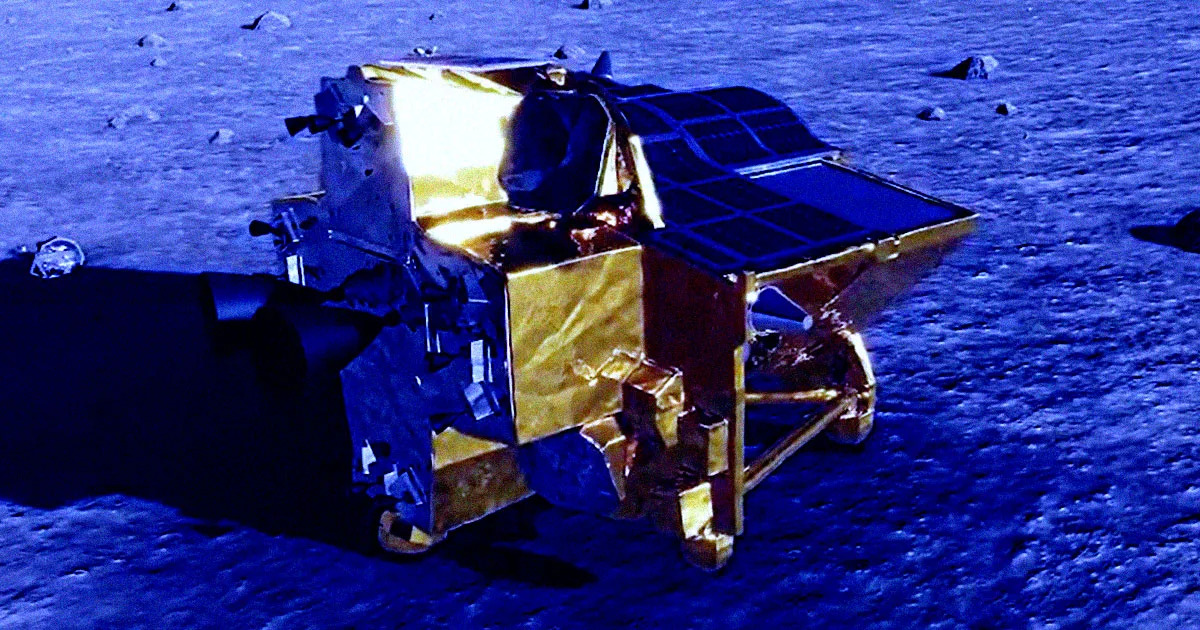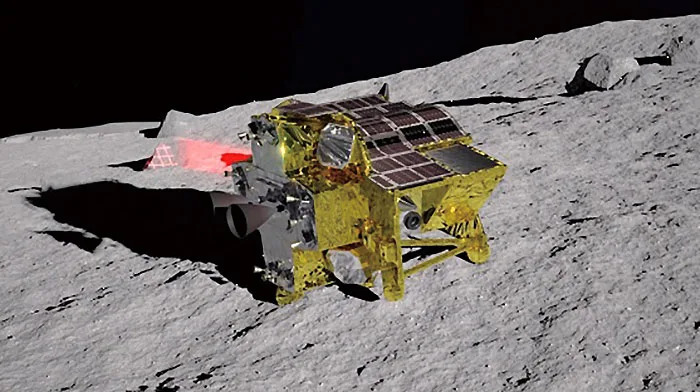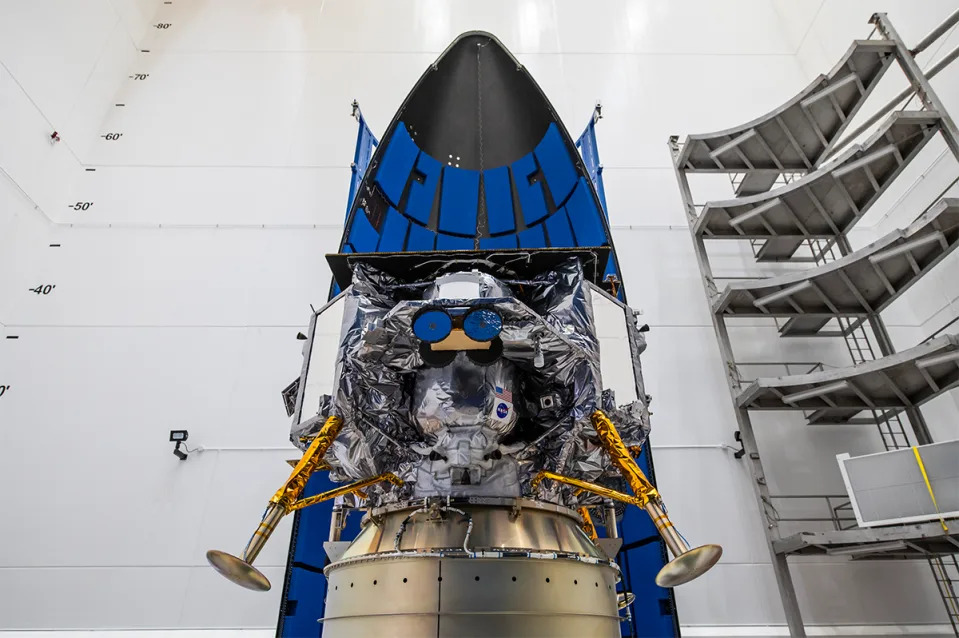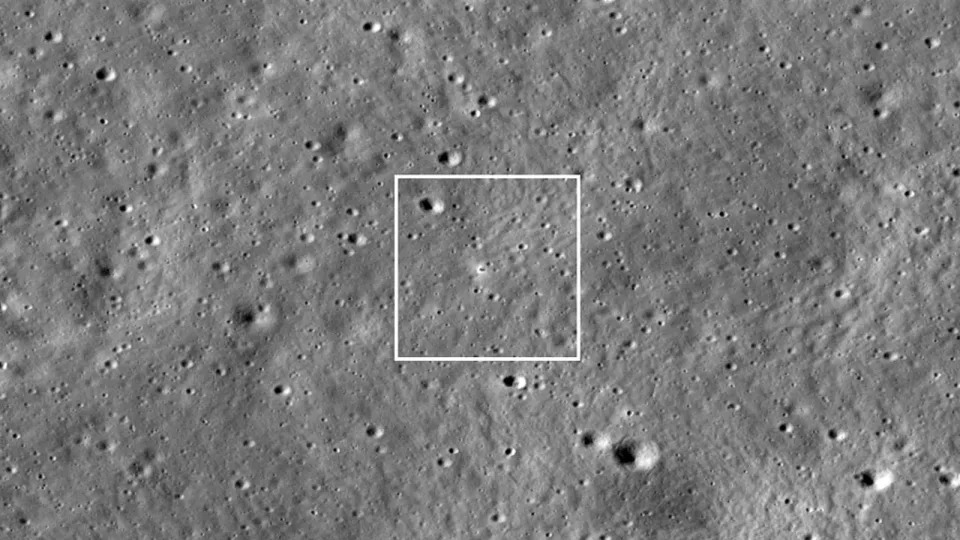Japan Trying to Bring Dead Moon Lander Back to Life
Victor Tangermann
Mon, January 22, 2024

Bring Me to Life
Japan's Smart Lander for Investigating Moon (SLIM) lander had to be shut down just three hours after touching down on the lunar surface last week.
The lander, which technically speaking still managed to make Japan the fifth country to land a spacecraft on the surface of the Moon, didn't quite stick the landing. For hours, teams at the Japan Aerospace Exploration Agency struggled to get the spacecraft to charge its batteries using its solar panels.
As it turns out, the issue is that the panels were pointing west and away from the Sun.
While that may sound like the small spacecraft's fate is sealed, JAXA isn't ready to give up just yet. There's still a chance SLIM may jump back to life, giving it a potentially new lease on life.
"If sunlight hits the Moon from the west in the future, we believe there's a possibility of power generation, and we're currently preparing for restoration," JAXA wrote in a new statement.
Going Under
At first, the mission appeared to go as planned, with the spacecraft making a controlled descent to the Moon's cratered surface. Several hours of radio silence from JAXA followed, triggering speculation about the lander's fate.
Behind the scenes, teams had to act quickly as battery capacity was diminishing quickly.
"The battery was disconnected according to our procedures with 12 percent power remaining, in order to avoid a situation where the restart (of the lander) would be hampered," the latest statement reads.
Scientists are now poring over the data SLIM managed to collect before it went dark.
"We were able to complete the transmission of technical and image data acquired during the descent and on the lunar surface before the power was switched off," JAXA said. "We’re relieved and beginning to get excited after confirming a lot of data has been obtained."
It's a glimmer of hope — with the possibility of the Sun charging the spacecraft's solar panels still on the table, scientists are eager to have SLIM jump back into action.
And even if it doesn't, it's still a considerable feat that's worth celebrating, especially considering all of the failed landing attempts that preceded it.
"The post-landing posture didn’t go as planned, but we may be able to produce plenty of results and we’re happy that the landing succeeded," JAXA's statement reads.
More on the mission: Japanese Moon Lander Dying After Touching Down on Lunar Surface
Sunlight May Reignite Japan’s Struggling 'Lunar Sniper' on the Moon
George Dvorsky
Mon, January 22, 2024

Artistic depiction of SLIM on the Moon.
Japan’s space agency, JAXA, achieved a historic soft landing with SLIM on Friday morning, but the lander ran into instant trouble by not being able to collect solar energy and generate electricity. Hopeful for some westerly sunshine, JAXA is cautiously optimistic that SLIM could spring back to life in a couple of weeks.
Shortly after its landing on Friday, January 19, JAXA reported issues with SLIM’s solar cells, which were not generating sufficient electricity. On Monday, JAXA revealed that it had shut down the system approximately three hours after landing to conserve its remaining power, as the space agency noted on X. The decision was made when SLIM’s battery level fell to 12 percent, as this low battery level threatened to cause issues for future recovery if mission controllers didn’t disconnect it in time.
Despite these challenges, there is some positive news from JAXA. The agency reported that technical and image data acquired during SLIM’s descent and active time on the lunar surface were successfully transmitted back to Earth before power was switched off. JAXA plans to release more details by the end of the week, including word on whether SLIM managed to land within its constrained target area. We’re looking forward to seeing the photos taken from the surface as well.
In addition to its primary mission (the precision landing), SLIM carried two smaller rovers, which preliminary data suggests were ejected as planned before the lander touched down. It also housed various scientific instruments, including an infrared camera, thermometer, and radiation detector. The success of these elements of the mission remains to be fully assessed.
This milestone for JAXA comes in the wake of a recent setback in lunar exploration when Astrobotic’s Peregrine lander failed shortly after reaching space due to a propellant leak. Landing on the Moon remains an incredibly challenging endeavor, even with 21st-century technology.
Japanese lunar lander touches down and Axiom space launches its third mission with SpaceX
Aria Alamalhodaei
Mon, January 22, 2024
Hello and welcome back to TechCrunch Space. What a week! For the second week in a row, we have lunar lander news to report on. Plus, a final update on Astrobotic's Peregrine lander, news on the Artemis program and the first crewed launch of the year.
Want to reach out with a tip? Email Aria at aria.techcrunch@gmail.com or send me a message on Signal at 512-937-3988. You can also send a note to the whole TechCrunch crew at tips@techcrunch.com. For more secure communications, click here to contact us, which includes SecureDrop (instructions here) and links to encrypted messaging apps.
Story of the week
How could the story of the week be anything other than SLIM (Smart Lander for Investigating Moon), the Japanese lunar lander that touched down on the moon on Friday?
This makes Japan the fifth country to put a lander on the moon, joining the ranks of the United States, China, Russia and India. The Japanese Aerospace Exploration Agency (JAXA) confirmed that they had received telemetry data from SLIM just after 10:20 AM EST.
While the landing was a success, not all went to plan, unfortunately: JAXA later said that the lander's solar cells are not currently generating electricity, which means that the mission lifetime will be greatly reduced. There's a small chance that the solar cells could charge as the angle of the sun changes, but that depends on whether the cause is due to a pointing issue or some other anomaly, JAXA officials said in a press conference.
But even with the issue, the mission achieved a huge portion of its goal, which was to demonstrate a soft lunar landing using optical navigation technology. This new type of technology can help ensure "pinpoint" landings, or landings with an accuracy of around 100 meters, as opposed to many kilometers.

Image Credits: Japan Aerospace Exploration Agency
Launch highlights
We saw our first crewed mission this year – but even more notably, it was a completely private mission (as in not a NASA astronaut mission). Axiom Space launched its third mission with launch partner SpaceX on Thursday, with the crew successfully docking with the International Space Station at 5:42 AM EST on Saturday, January 20.
Axiom's plan is to continue flying these private missions to the ISS at a pace of around two missions per year through 2026, which is when the company hopes to launch its first commercial space station module, Derek Hassmann, chief of mission integration and operations at Axiom Space, said during a prelaunch press conference. Axiom's fourth flight, Ax-4, is scheduled for later this year, though a specific launch window has not been announced.

axiom 3 mission
Image credit: SpaceX
Loren Grush very nicely lays out some of NASA's forward-thinking strategy with its Commercial Lunar Payload Services (CLPS) program: accept some risk. The program was established to help kickstart the development of payload delivery surfaces to the moon's surface, and it stands in sharp contrast to NASA's standard quo.
Astrobotic's Peregrine lander, which suffered a fatal propulsion leak that prevented the spacecraft from having any chance of landing on the moon, is the result of a CLPS award. While Astrobotic did not complete the mission, Grush describes how NASA designed the program to be more risk-tolerant than its other endeavors.

peregrine astrobotic ula vulcan. lunar laner loaded in nose of rocket
Astrobotic Peregrine Lunar Lander
This week in space history
Thirty-two years ago this week, microgravity research was born. In 1992, NASA launched the first International Microgravity Laboratory on board the space shuttle Discovery, and it carried a number of scientific research and experiments looking into the effects of zero G on materials and living organisms. The lab was pressurized, so the mission also carried a crew of seven; they returned to Earth after eight days in space.

Crew of STS-42
Image credit: NASA
NASA bounces laser off 'Oreo-sized' mirror on the moon for 1st time, paving the way for high-precision lunar landings
Harry Baker
Mon, January 22, 2024

The Chandrayaan 3 mission's Vikram lander photographed on the moon's surface by the Pragyan rover.
NASA has successfully bounced a laser beam off of an "Oreo-sized" mirror on India's historic lunar lander and back to the orbiting spacecraft that fired it. This feat is the first time that such a maneuver has ever been carried out, and it could help facilitate high-precision landings during future missions to the moon.
In August 2023, India became the fourth nation to land a spacecraft on Earth's largest satellite when the country’s Chandrayaan-3 mission deployed the Vikram lunar lander near the Manzinus crater in the moon's south pole region. The lander, which was also carrying the Pragyan rover, spent weeks collecting data on the moon — including valuable evidence of moonquakes — but failed to wake up after a scheduled power down in September. But the defunct lander is still of great interest to NASA.
Before the misssion began, the agency arranged to have a small, multi-sided mirror, known as a laser reflector array or retroreflector, attached to the lander. The 2-inch-wide (5 centimeters) device, which is made from eight quartz-corner-cube prisms set into a dome-shaped aluminum frame, is designed to reflect lasers to orbiting spacecraft from almost any incoming angle.
Related: Humanity's future on the moon: Why Russia, India and other countries are racing to the lunar south pole
Ever since the lander went offline, NASA's Lunar Reconnaissance Orbiter (LRO), which is the only laser-armed spacecraft currently circling the moon, has repeatedly tried to bounce lasers off the retroreflector with no success. But on Dec. 12, 2023, after eight failed attempts, LRO finally hit the array from 62 miles (100 kilometers) away and received a laser ping in return.
The long-awaited success is an important proof-of-concept for NASA, which is planning to use more retroreflectors in future missions to the moon, including the upcoming Artemis missions.
"We've showed that we can locate our retroreflector on the surface from the Moon's orbit," Xiaoli Sun, a research scientist at NASA's Goddard Space Flight Center who led the mission, said in a statement. "The next step is to improve the technique so that it can become routine for missions that want to use these retroreflectors in the future."

A gold colored semi-sphere covered with 8 round mirrors
This is not the first time scientists have bounced lasers off the moon. In the past, NASA has successfully reflected Earth-fired lasers off reflective panels that were left behind on the lunar surface during the Apollo missions. This has revealed that the moon is slowly moving away from Earth by about 1.5 inches (3.8 centimeters) every year.
However, the new retroreflectors were designed with a more practical use in mind. NASA plans to use the devices to help unmanned spacecraft land next to existing objects on the moon by being able to measure exactly how far away they are from the surface (based on how long it takes for the lasers to bounce back to the spacecraft).
This would be important for building future lunar bases and could also allow astronauts to land in complete darkness on the far side of the moon. Similar "precision markers" help incoming astronaut capsules and cargo pods to dock with the International Space Station's airlocks.
Related: 15 incredible images of Earth's moon

An aerial view of the Vikram lunar lander from orbit
It took LRO multiple attempts to successfully reflect lasers off the Vikram lander because the orbiter was not designed with such precise maneuvers in mind. The spacecraft, which is currently operating 13 years past its original mission parameters, was designed to map the lunar surface. To do this, it fires bursts of thin laser lines toward the moon and measures how long it takes for them to bounce back to the spacecraft. But because these lines are spaced far apart, it made it hard to accurately hit such a small target.
Future spacecraft that target the retroreflectors will have more precise lasers and likely be firing them from much closer distances. So, in theory, they should be able to hit their tiny targets every time, according to NASA.
related stories
—NASA's 1st successful 2-way laser experiment is a giant leap for moon and Mars communications
—South Korea's lunar orbiter unveils jaw-dropping images of Earth and the moon
—Earth receives laser-beam message from 10 million miles away in new NASA experiment
NASA is planning to put more retroreflectors on the moon to run similar experiments in the future. However, their last few attempts have not gone well.
One of their proposed retroreflectors was onboard the privately-owned Peregrine lunar lander, which recently burned up in Earth's atmosphere after suffering a catastrophic propellant leak shortly after launching on Jan. 8. Another was attached to Japan's SLIM lander, which successfully landed on the moon on Jan. 19 but may already be dead after a problem with its power source. (It is currently unclear if the retroreflector on the SLIM lander could still be used by NASA.)
These issues may have set back NASA's research into retroreflectors. But since the first manned Artemis mission has been delayed until 2026, they will likely get several more chances before those missions come around.

















![The Snow Queen, by Edmund Dulac [1911] (Public Domain Image)](https://sacred-texts.com/pag/sor/img/snowquee.jpg)











